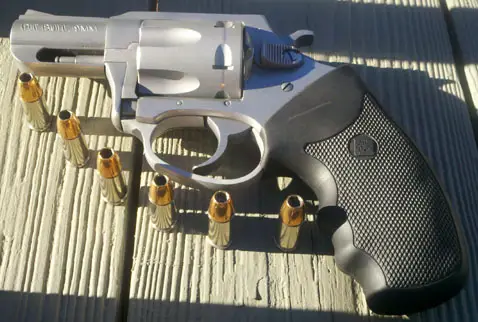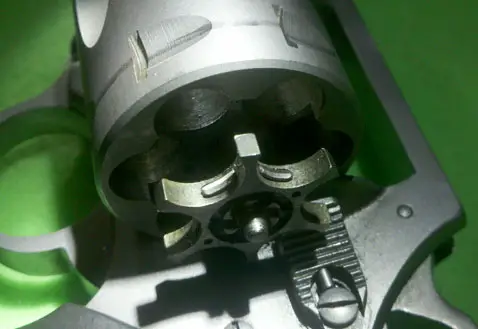|
Charter Arms Pitbull 9x19mm Rimless Revolver By Mark Wynn  Getting comfortable with a new Charter Arms Pitbull 9mm rimless revolver is easier after becoming a gun whisperer and bonding with its uniqueness, the way it feeds and ejects ammo. The Model 79920 looks and feels great, but the break-in period is mostly about getting used to what happens when spring tips guard the entries to the chambers of a revolver cylinder. First, a little perspective. The first Pitbull was the world's first .40 caliber rimless revolver. Announced Aug. 10, 2011, the Pitbull offered the law enforcement market a same-cartridge revolver backup for .40 S&W semiautomatics. The 9mm six-shooter followed on July 31, 2012 and a .45 ACP is in the works. Pitbulls are so new and difficult to locate that they can command the full list price of $465. I was eager to get a 9mm revolver complement to my Ruger SR9c autoloading pistol and Hi-Point 995TS carbine. I feed all of them 147-grain Federal HST HP ammo for defense and Speer Lawman total metal jacket (TMJ) for indoor range. I also use some American Eagle 115-grain FMJ for lighter load validation. The unique plus of a rimless cartridge revolver is ammunition compatibility with 9x19mm autoloading pistols. The minus is that the spring loaded tabs added to the extractor star to catch the extractor groove of a rimless case make the revolver more difficult to load and, after firing, to extract/eject the empty cases.  The first 200 rounds through my new 9mm Pitbull included some misfires, cylinder lockup and hammer freeze. Except for an occasional cartridge failure to eject, these issues were resolved in the next 100 rounds, as the 9mm got broken-in and I got more familiar with its operation. Charter Arms recommends its revolvers be cleaned after every 50 rounds and I was shooting 100 at a time. With a rimless revolver like the Pitbull, it is particularly important to make sure each cartridge is fully seated in the chamber. If any cartridge sticks out just a little, it could lock up cylinder rotation. With the Pitbull's lifetime guarantee, I can send it to Charter Arms any time for inspection and repair as necessary (IRAN, as the military says). However, I see no need to do that, as long as I am comfortable that the Pitbull will fulfill its primary mission of letting me fire six 9mm rounds whenever I need them. Charter Arms recommends +P not be used: �+P ammo requires a four-inch minimum barrel to burn the extra powder. Therefore, in a two-inch barrel the extra powder is burned after the bullet leaves the barrel, creating more recoil and making it harder to come back to target.� No problem, especially for those preferring the reduced recoil and blast of subsonic 147-grain 9mm. 147-grain hollow point has plenty of penetration and expansion, including at snubby distances. A few other companies have produced 9mm revolvers in the past, e.g., S&W 940 and Ruger 9mm SP101. Most used moon clips, as does the current Taurus Model 905. Cartridges have to be loaded into the moon clips, then inserted into the cylinders. The clips are relatively fragile, but serve as speed loaders. A different option for single-action revolvers is a separate 9mm cylinder, as on the Ruger Blackhawk .357 convertible model. Some claim 9mm is less accurate than .357 or .38, because its bullet is slightly smaller (.355) than the diameter of the .357 / .38 barrel. (An assertion we have found to be true in our testing. -Editor) Perhaps the Pitbull's most similar rimless revolver cartridge predecessor was the Smith & Wesson Model 547. The S&W 547 design, �Extractor assembly for rimless cartridges,� is U.S. Patent 4,127,955 from Dec. 5, 1978. The patent notes that one of the advantages of a rimless revolver mechanism is unfired cartridges not freely falling from the open cylinder, even if held with the barrel pointed up. No moon clips are needed for the Charter Arms 9mm Pitbull. Cartridges are supposed to behave via patented dual coil springs in the extractor star. However, the springs, at least when new, are fickle. Sometimes a 9mm cartridge slips into a chamber with just a bit of a push. Other times a cartridge will balk, even after being wiggled and rotated. Some aggravation is because Charter Arms did not include any rimless revolver information in the Operation Instructions with the revolver I bought in January 2013. The information mentions 14 Charter Arms revolvers, but not the 9mm or .40 Pitbull models. Neither was detailed loading and extraction information available for either rimless revolver at charterarms.com. Not telling customers how the springs work and how to work the springs causes avoidable frustration, because the key innovation is loading and ejecting rimless cartridges. The six-cartridge ejector star inner springs are literally the gatekeepers going in and the guards going out. It can be just as difficult to extract cartridges after they are fired as to get fresh cartridges into the chambers. Most of the time the ejector rod will push out as smoothly as a regular DA revolver using rimmed cartridges, but sometimes the front of the ejector rod has to be tapped with something solid to budge it and eject the cartridges. Sometimes a spent cartridge will still need to be poked out individually. The fixed sight 9mm Pitbull at seven yards does best aimed when at 12 o'clock with the front sight slightly higher than the rear. Best six-shot offhand results for me are within three inches, slightly left either double or single action, one-handed or two-handed. Close enough for center of mass hits. After those vexing first 200 rounds, I repeatedly dry-fired, loaded, unloaded, cleaned and lubricated the gun at home. I also ran 0000 steel wool gently through each chamber, after examining the entire gun with a magnifying glass. Everything looked and felt fine. Nevertheless, sometimes shells would not load and the ejector rod would stick. After studying many Internet articles and comments about the Pitbull 9mm and .40 S&W, pro and con, I finally came to understand that while the loading and ejection culprits are the coil springs, it is not obvious exactly where they are and what the problem is. The only loading pressure that does any good is pressing the rear of the cartridge against the tiny spring tip/plunger/nib/detent at the inside of each crescent in the six-point ejector star. This is most clearly studied when the ejector rod is pushed out. Then, with the ejector star flush against the rear of the cylinder, insert a cartridge straight in or with the head at a slight angle outward until resistance is felt. Press the cartridge toward the inside of the chamber, against the spring tip, while pushing the cartridge inward. If still balky, twist the cartridge slightly. Once that is figured out, the Charter Arms Pit Bull starts acting more like a regular revolver, with a little more effort in loading and unloading. Later I also added some extra fine dry powder graphite lube to each spring tip. Like previous manipulations, it seemed to help a little. Progress is incremental more than breakthrough. Whatever device is used to facilitate loading a 9mm Pitbull, each cartridge will need a final pressing-in. No circular speed loader was available in January 2013, but strip loaders worked fine. I like the Tuff QuickStrip Model 7002-BP-6327 or -8327 for comfortably inserting two 9mm cartridges at a time. Some recommend loading from loaded 9mm pistol magazines, but that is more challenging than flexible strip loaders. For carry, two strip loaders fit nicely in a single magazine pistol pouch. Eight-rounders pull out easiest and provide four extra rounds. If you count the time and effort to load pistol magazines, especially stiffer double stack magazines, loading a revolver doesn't take so much time, after all. Neither do revolvers need magazine loading assistance devices. So far, my favorite holster is Uncle Mike's Open-Top Inside-the-Pocket Holster No. 4. For best pocket fit, substitute optional combat small rubber grips. As it comes, with full rubber grips, the Pitbull is a reasonable fit for inside-the-waistband holsters. The 9mm Pitbull is about the same size as a Ruger SR9c pistol, slightly wider and five ounces lighter. The trigger pull is smooth, heavy for double action safety and light for single action precision. Recoil and flash are acceptable, although a lightweight 9mm snub nose revolver is not a fun plinker. A snubby's main virtue is for concealed carry, with sufficient close range stopping power. 9mm gives the Pitbull a sixth shell advantage over comparable five-shot revolvers. Its 2.2-inch barrel is a nicer balance than shorter snubs. Specifications:
The 9mm Pitbull comes in a plastic case with Operating Instructions and Safety Precautions, metal external trigger lock and a fired 9mm shell casing. Options available from Charter Arms include Crimson Trace Laser Grips ($199.95), hip grips in black or white ($24.95), combat small rubber grips ($19.95), grips in pearlite or pink ($49.95), combat full rubber grips in pink, purple, or brown ($19.95) and five types of holsters from $15.95 to $29.95. The small rubber grips reduce the gun's height to 4-1/4" and length to 6-1/2". Charter Arms is totally about American-made revolvers. The virtues of revolvers are well known. A good summary is at charterarms.com, Press Releases, �Advantages of a Charter Arms Revolver for Civilian Personal Self Defense and Professional Back Up.� Once its novel rimless loading and unloading is understood and manageable, the Charter Arms 9mm Pitbull rimless revolver is an innovative approach for carry or home defense. |